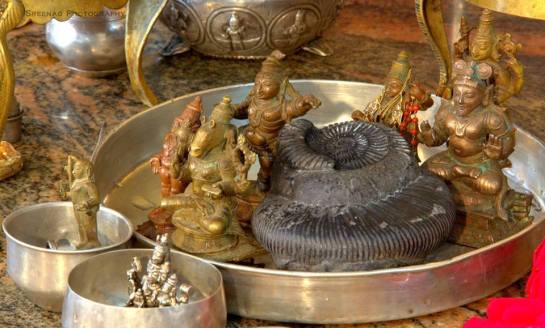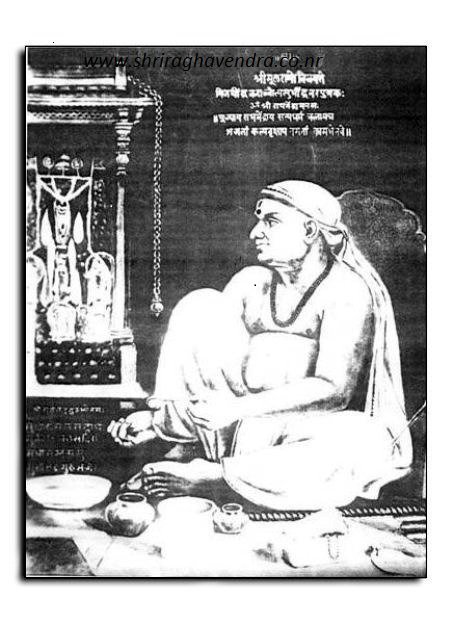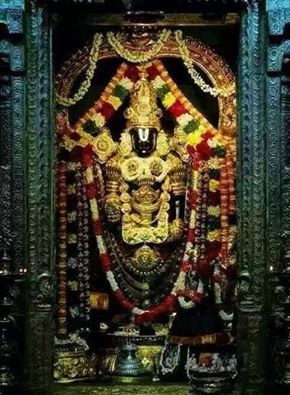Gopi Chandana Naama Mudradharane Vidhaana
For the spiritual progress of a Human Being, both internal austerity as well as external austerity is quite essential. While noble thoughts and devotion to God constitute the practices such as Gopichandana Nama Mudra Dharana constitute the external austerity. Many of our holy scriptures proclaim that both of these are very essential for a person.
Procedure for Mudradharana for Men
What you need:
1. A block of Gopichandana
2. Two separate vessels (one containing water for achamana and other for Vishnu nirmalya)
3. Pancha Mudra Set (Chakra, Shanka, Gada, Padma, Narayana Mudra)

In the morning wake up as early as possible and take bath with proper sankalpa. Then wear “austere clothes” (pancha and uttariya). The Upendra form of Vishnu is to be remembered while wearing clothes. After duly wearing the clothes, recite the following mantra:
apavitraH pavitro vA sarvAvasthAM gato.api vA .
yaH smaret puNDarIkAxaM sa bAhyAbhyantaraH suchiH ..
Inspite of all our efforts to keep oursevles pure, we knowingly or unknowingly become impure by our deeds and thoughts. So, pray to Pundarikaksha Vishnu. He will, at once, render you pure, both internally and externally.
Now is the time to do Achamana, Pranayama and Sankalpa for Gopichandana Mudra Dharana.
Importance of Achamana
From ages, our ancestors have been giving great prominence to saucha or purity ? both external as well as internal. Achamana is a simple and effective process prescribed in our scriptures for internal purification.
This is necessary while performing any religious act.
yAH kR^iyAH kurute mohAt anAcamya ca nAstikaH |
bhavanti vyarthAstasya kR^iyAH sarvA na saMshayaH | – hArIta smR^iti
According to hArIta smR^iti any religious act performed without doing Achamana is futile.
bhavanti saphalAH sarve samAcamati yo dvijaH |
All the acts of a dvija who performs the achamana will be fruitful.
One must look at the episode of uttanka from mahabhArata to understand the significance of purity achieved through Achamana.
The story runs thus: After completing his studies at the gurukul, uttanka wants to offer gurudakshina to his guru. But his guru is reluctant to specify anything and asks him to request his wife if she has any desire to be fulfilled. Uttanka asks his guru patni but she is also initially reluctant. But after repeated persuasion, she expresses her desire to wear the ornament of the queen while serving the Brahmins in an upcoming religious function. Uttanka sets out for the palace of king paushya to fulfill the wish of his guru?s wife. En route, with an intention to test him, indra deva appears and asks him to eat cow dung because his guru has also done so. Uttanka believes him and partakes the cowdung and urine. He proceeds to the king?s palace without doing Achamana. He meets king paushya and tells him about his need to fulfill his guru dakshina. The king asks him to see the queen who is inside the palace. But amazingly the queen is invisible to uttanka. He returns to the king and says ?I cannot find the queen inside?. To this the king replies ? ?surely you are impure. The queen being a devoted wife (a pativrata) cannot be seen by impure persons?. Uttanka realizes his mistake. He says to himself – ?Oh! I did not perform Achamana after partaking the cowdung?. Immediately, he sits facing east and performs the Achamana as prescribed in the scriptures. He goes inside the palace. To his surprise he finds the queen there.
Look at the profound effect of sipping three drops of water and the greatness of pAtivratya! In this age we cannot totally comprehend the level of purity our ancestors used to maintain. At the least, we get an idea of how low we are in terms of purity when compared to our ancestors.
Detailed information about Achamana, Pranayama and Sankalpa would be given in a separate article. Here it is assumed that the reader is familiar with these procedures.
For wearing Gopichandana and Mudras, the sankalpa should conclude thus – shrI bhAratIramaNa mukhyaprANantargata shrI viShNu preraNayA shrI viShNuprItyartham gopIchandana tilakAyudha tulasIkAShTamAlAdi dhAraNaM kariShye.
Prayer to Gopichandana
Now say this prayer to the auspicious Gopichandana to remove all sins and lead you to liberation
gopIchandana pApaghna viShNudeha samudbhava .
chakrAnkita namastubhyaM dhAraNAnmuktido bhava ..
O gopichandana, born from the body of Vishnu, the remover of sins, O chakrAnkita, I salute you. I smear you on my body, do lead me to salvation.
Now, put some water on your left palm and rub the block of Gopichandana in clock-wise direction to create a soft paste.
Say the following prayers
| Sl.No |
When |
What to say…? |
| 1 |
Fetching water |
imaM me gange yamune sarasvati shutudri stomam sachatA paruShNyA.asiknyA marudvR^idhe vitastayA.a.arjIkIye shR^iNuhyA sushomayA ..(R^ig 10.75.5) |
| 2 |
Placing gopichandana on the left palm to extract paste |
gandhadvArAM durAdharshAM nityapuShTAm karIShiNIm .IshvarIM sarvabhUtAnAM tAmihopahvaye shriyam .. |
| 3 |
While extracting paste |
viShNornukaM vIryAni pravocam yaH pArthivAni vimame rajAMsi .yo askabhAyaduttaraM sadasthaM vichakramANastredhorugAyaH .. |
| 4 |
On the extracted paste |
write Nrisimha Bijakshara -the Narasimha Beejakshara is
” KshrOum “ |
| 5. |
close your left palm with right palm |
ato deva avantu no yato viShNurvicakrame . prithivyA saptadhAmabhiH . idaM viShnurvicakrame tredhA nidhAdhe padaM . samUlhamasya pAMsure .. |
|
..do..
|
om shrIviShNave namaha (three times) |
|
Apply the gopichandana (see table below) |
|
Procedure for nama mudra dharana as enshrined in Shri Vishnupurana.
| Sl.No |
Place on body |
Shape |
Saying … (during Shukla Paksha) |
Saying … (during Krishna Paksha) |
| 1 |
Lalata – Forhead |
Dandakara (apply vertically up with index finger and then wipe the central part with a fine cloth splitting it into two parellel lines) |
Keshavaya Namaha |
Sankarshanaya Namaha |
| 2 |
Udara Madhya – Middle of Stomach |
Deepakriti (in the shape of a lamp) |
Narayanaya Namaha |
Vasudevaya Namaha |
| 3 |
Vakshasthalam – Middle portion of Chest |
Kamala (like the bud of Kamala flower) |
Madhavaya Namaha |
Pradyumnaya Namaha |
| 4 |
Kantha Madhya – Front Middle portion of neck |
Deepakriti (in the shape of a lamp) |
Govindaya Namaha |
Aniruddhaya Namaha |
| 5 |
Udara Dakshina – Right Side of Stomach |
Deepakriti (in the shape of a lamp) |
Vishnave Namaha |
Purushottamaya Namaha |
| 6 |
Dakshina Bhuja – Right shoulder |
Venupatrakriti (in the shape of the leaf of a Bamboo tree) |
Madhusudanaya Namaha |
Adhokshajaya Namaha |
| 7 |
Kantha Dakshina – Right Side of the Neck |
Deepakriti (in the shape of a lamp) |
Trivikramaya Namaha |
Narasimhaya Namaha |
| 8 |
Udara Vama – Left Side of Stomach |
Deepakriti (in the shape of a lamp) |
Vamanaya Namaha |
Achyutaya Namaha |
| 9 |
Vama Bhuja – Left Shoulder |
Venupatrakriti (in the shape of the leaf of a Bamboo tree) |
Shridharaya Namaha |
Janardanaya Namaha |
| 10 |
Kantha Vama – Left Side of the Neck |
Deepakriti (in the shape of a lamp) |
Hrushikeshaya Namaha |
Upendraya Namaha |
| 11 |
Prishta Adhobhaga – Back side on the lower spinal chord |
Deepakriti (in the shape of a lamp) |
Padmanabhaya Namaha |
Haraye Namaha |
| 12 |
Katha Prishta Bhaga – Back side of the Neck |
Deepakriti (in the shape of a lamp) |
Damodaraya Namaha |
Sri Krishaya Namaha |
Chakra mudra dharane vidhaana

It is applied in the chintanye of Ambarisavarada for rakshane and to get sat-buddhi to follow Dharma.
Chant the following mantra while applying chakra mudra:
sudarshana mahajwala kotisoorya samaprabha |
agnandhasyame nithyam vishnOrmaargam pradarshaya ||
one on right side of eye, five on centre of abdomen, three on heart, two on right of abdomen, three on right of chest, two on right shoulder both sides of naama, two on right of neck, one on front of neck, one on left shoulder below the naama.
Shanka mudra dhaarane vidhana

It is applied in the chintanye of dhruva varada for jnana prapthi and to get the blessings of goddess Lakshmi.
Chant the following mantra while applying chakra mudra:
paanchajanya nijadhwana dvamstapaathaka namchaya |
traahimaam paapinam GorasamsaaraarNava paatyinam ||
one on left side of eye, one on left of abdomen, two on left of chest, two on left shoulder both sides of naama, two on left of neck, one on right shoulder below the naama.
Gada mudra dhaarane vidaana

It is applied in the chintanye of vayu varada for vairagyaprapthi and to get control over desires.
Chant the following mantra while applying gada mudra:
brahmaanda bhuvanaaramba mUlastambO gadaadhara |
kaumOdakI karEyusya tham namaami gadaadharam ||
one on forehead, one on left of abdomen, one on left of chest, two on left shoulder both sides of naama below shankha mudra.
Padma mudra dharana vidhaana

It is applied in the chintanye of lakshmee varada for aishvarya prapthi and to get peace and tranquility.
Chant the following mantra while applying padma mudra:
samsaara bhayabEEtaanam yOginaamabhayapradha |
padmahastEna yO dEvO yOgIsham tham namaamyaham ||
Two on chest, two on right abdomen, two on right shoulder both sides of naama below chakra mudra.
Narayana Mudra dhaarane vidhaana

naarayana mudre hachidavanannu bhakthiyinda nodidavana uddara
Chant the following mantra while applying narayana mudra:
naarayana namastEstu naamamudraamkitam naram |
druStyava labhatE mukthim chamdaalO brahmagaathaka ||
One each overlapping on all mudras, and naama.
The mudrA dhAraNa vidhi according to prakAsha saMhita is as follows
chakra mudrA
2 beside right eye
4 on stomach
2 on chest
2 on right hand
between two gadA mudrAs on left hand
2 on right side of neck
1 on the beginning portion of neck
1 on upper portion of spinal chord
1 on lower portion of spinal chord
Sha~Nka mudrA
2 beside left eye
2 on left chest
between two padma mudrAs on right hand
2 on left hand
2 on left side of neck
1 on chest
1 on back of neck
1 on upper portion of spinal chord
gadA mudrA
1 on forehead
2 on left hand (below two sha~Nka mudrA)
padma mudrA
1 on central portion of chest
2 on right hand (below two chakra mudrAs)
1 on right portion of chest
nArAyaNa mudrA
on all mudrAs
on top of the head (one should wear all the five mudrAs on top of head)
** With due credits to the UM website and harithasya.wordpress.com **

















